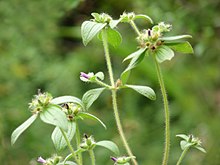Melastomataceae
| Melastomataceae Temporal range:
| |
|---|---|

| |
| Pleroma semidecandrum, syn. Tibouchina semidecandra, at Strybing Arboretum, San Francisco | |
| Scientific classification | |
| Kingdom: | Plantae |
| Clade: | Tracheophytes |
| Clade: | Angiosperms |
| Clade: | Eudicots |
| Clade: | Rosids |
| Order: | Myrtales |
| Family: | Melastomataceae Juss.[2] |
| Type genus | |
| Melastoma | |
| Genera | |
|
See text. | |


Melastomataceae (
Description
The leaves of melastomes are somewhat distinctive, being
Flowers are perfect, and borne either singly or in terminal or axillary, paniculate cymes.
Ecology
A number of melastomes are regarded as
Taxonomy
Under the APG III system of classification, the seven genera from Memecylaceae are now included in this family.[2]
Genera
There are some 167 accepted genera in the Melastomataceae family as of October 2023. They are:[5]
- Acanthella Hook.f.
- Aciotis D.Don
- Acisanthera P.Browne
- Adelobotrys DC.
- Allomaieta Gleason
- Alloneuron Pilg.
- Almedanthus Ver.-Lib. & R.D.Stone
- Amphiblemma Naudin
- Amphorocalyx Baker
- Anaheterotis Ver.-Lib. & G.Kadereit
- Andesanthus P.J.F.Guim. & Michelang.
- Anerincleistus Korth.
- Antherotoma (Naudin) Hook.f.
- Appendicularia DC.
- Argyrella Naudin
- Arthrostemma Pav. ex D.Don
- Aschistanthera C.Hansen
- Astrocalyx Merr.
- Astronia Blume
- Astronidium A.Gray
- Axinaea Ruiz & Pav.
- Bamlera K.Schum. & Lauterb.
- Barthea Hook.f.
- Beccarianthus Cogn.
- Bellucia Neck. ex Raf.
- BennaBurgt & Ver.-Lib.
- Bertolonia Raddi
- Bisglaziovia Cogn.
- Blakea P.Browne
- Blastus Lour.
- Boerlagea Cogn.
- Bourdaria A.Chev.
- Boyania Wurdack
- Brachyotum (DC.) Triana
- Brasilianthus Almeda & Michelang.
- Bredia Blume
- Bucquetia DC.
- Cailliella Jacq.-Fél.
- Calvoa Hook.f.
- Cambessedesia DC.
- Castratella Naudin
- Catanthera F.Muell.
- Centradenia G.Don
- Centradeniastrum Cogn.
- Centronia D.Don
- Chaetogastra DC.
- Chaetolepis (DC.) Miq.
- Chalybea Naudin
- Cincinnobotrys Gilg
- Comolia DC.
- Comoliopsis Wurdack
- Creochiton Blume
- Cyphotheca Diels
- Dalenia Korth.
- Derosiphia Raf.
- Desmoscelis Naudin
- Dicellandra Hook.f.
- Dichaetanthera Endl.
- Dinophora Benth.
- Dionycha Naudin
- Dionychastrum A.Fern. & R.Fern.
- Dissochaeta Blume
- Dissotidendron (A.Fern. & R.Fern.) Ver.-Lib. & G.Kadereit
- Dissotis Benth.
- Driessenia Korth.
- Dupineta Raf.
- Eleotis Ver.-Lib. & R.D.Stone
- Eriocnema Naudin
- Ernestia Naudin
- Feliciadamia Bullock
- Feliciotis Ver.-Lib. & G.Kadereit
- Fordiophyton Stapf
- Fritzschia Cham.
- Graffenrieda DC.
- Gravesia Naudin
- Guyonia Naudin
- Henriettea DC.
- Heteroblemma (Blume) Cámara-Leret, Ridd.-Num. & Veldkamp
- Heterocentron Hook. & Arn.
- Heterotis Benth.
- Huberia DC.
- KendrickiaHook.f.
- Kerriothyrsus C.Hansen
- Kirkbridea Wurdack
- Lijndenia Zoll. & Moritzi
- Lithobium Bong.
- Loricalepis Brade
- Macairea DC.
- Macrocentrum Hook.f.
- Macrolenes Naudin
- Maguireanthus Wurdack
- Mallophyton Wurdack
- Marcetia DC.
- Medinilla Gaudich. ex DC.
- Melastoma L.
- †Melastomites[6]
- Melastomastrum Naudin
- Memecylon L.
- Meriania Sw.
- Merianthera Kuhlm.
- Miconia D.Don
- Microlicia D.Don
- Monochaetum (DC.) Naudin
- Monolena Triana ex Benth. & Hook.f.
- Mouriri Aubl.
- Neblinanthera Wurdack
- Neodriessenia M.P.Nayar
- Nepsera Naudin
- Nerophila Naudin
- Noterophila Mart.
- Nothodissotis Ver.-Lib. & G.Kadereit
- OchthephilusWurdack
- Ochthocharis Blume
- Opisthocentra Hook.f.
- Osbeckia L.
- Ossaea DC.
- Oxyspora DC.
- Pachycentria Blume
- Pachyloma DC.
- Phainantha Gleason
- Phyllagathis Blume
- Physeterostemon R.Goldenb. & Amorim
- Pilocosta Almeda & Whiffin
- Plagiopetalum Rehder
- Pleroma D.Don
- Plethiandra Hook.f.
- Poikilogyne Baker f.
- Poilannammia C.Hansen
- Poteranthera Bong.
- Preussiella Gilg
- Pseudodissochaeta Nayar
- Pseudoernestia Krasser
- Pternandra Jack
- Pterogastra Naudin
- Pterolepis (DC.) Miq.
- Pyrotis Ver.-Lib. & R.D.Stone
- Quipuanthus Michelang. & C.Ulloa
- Rhexia Gronov.
- Rhynchanthera DC.
- Rosettea Ver.-Lib. & G.Kadereit
- Rostranthera M.J.Rocha & P.J.F.Guim.
- Rousseauxia DC.
- Salpinga Mart. ex DC.
- Sandemania Gleason
- Sarcopyramis Wall.
- Schwackaea Cogn.
- Scorpiothyrsus H.L.Li
- Siphanthera Pohl
- Sonerila Roxb.
- Spathandra Guill. & Perr.
- Sporoxeia W.W.Sm.
- Stanmarkia Almeda
- Stussenia C.Hansen
- Styrophyton S.Y.Yu
- Tashiroea Matsum. ex T.Itô & Matsum.
- Tateanthus Gleason
- Tessmannianthus Markgr.
- Tibouchina Aubl.
- Tigridiopalma C.Chen
- Triolena Naudin
- Tristemma Juss.
- Tryssophyton Wurdack
- Vietsenia C.Hansen
- Votomita Aubl.
- Warneckea Gilg
- Wurdastom B.Walln.
Foraging
Melastomataceae is foraged by many stingless bees, especially by the species Melipona bicolor which gather pollen from this taxon of flowering plant.[7][clarification needed]
References
- ^ "Myrtales". www.mobot.org. Retrieved 2023-07-20.
- ^ hdl:10654/18083
- ISBN 978-3-030-99741-0, retrieved 2023-05-04
- .
- ^ "Melastomataceae Juss". Plants of the World Online. Royal Botanic Gardens, Kew. Retrieved 30 October 2023.
- doi:10.1130/MEM51.
- ^ Hilário, S. D., and V. L. Imperatriz-Fonseca. "Pollen foraging in colonies of Melipona bicolor (Apidae, Meliponini): effects of season, colony size and queen number." Genetics and Molecular Research 8.2 (2009): 664-671.
External links
- PlantSystematics.org: Images of species, list of genera[permanent dead link]
- Penneys, D. S.; Michelangeli, F. A.; Judd, W. S.; Almeda, F. (1 January 2010). "Henrietteeae (Melastomataceae): A New Neotropical Berry-Fruited Tribe". Systematic Botany. 35 (4): 783–800. S2CID 85228425.
